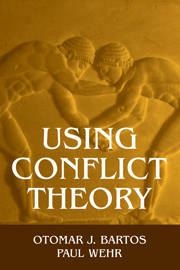Book contents
- Frontmatter
- Contents
- List of Figures and Tables
- Acknowledgments
- 1 Introduction
- 2 Understanding Conflict
- 3 Development of Incompatible Goals
- 4 Application to the Civil Rights Struggle
- 5 Emergence of Overt Conflicts
- 6 Application to a University Conflict
- 7 Escalation and Deescalation
- 8 Application to Conflict in Bosnia
- 9 Making Conflict Work Economically
- 10 Understanding and Managing Conflicts
- Appendix: Prelude to the Dissolution of Yugoslavia
- Notes
- References
- Index
6 - Application to a University Conflict
Published online by Cambridge University Press: 05 June 2012
- Frontmatter
- Contents
- List of Figures and Tables
- Acknowledgments
- 1 Introduction
- 2 Understanding Conflict
- 3 Development of Incompatible Goals
- 4 Application to the Civil Rights Struggle
- 5 Emergence of Overt Conflicts
- 6 Application to a University Conflict
- 7 Escalation and Deescalation
- 8 Application to Conflict in Bosnia
- 9 Making Conflict Work Economically
- 10 Understanding and Managing Conflicts
- Appendix: Prelude to the Dissolution of Yugoslavia
- Notes
- References
- Index
Summary
sometimes a conflict results not so much from direct discrimination and prejudice, as in the case of the civil rights movement, as it does from established ways of evaluating performance and from honest disagreement over standards and procedures to be used. In an organization, those disagreements can combine with friendship patterns, putting those who are without such ties – such as minority and women faculty – at a considerable disadvantage. They cannot benefit equally from membership in the “old boys network” or from long-standing and inflexible standards of evaluation. The result is what is commonly known as institutional racism and sexism. Here we use a conflict in a university to illustrate the theory developed in Chapter 5. Although in this chapter we focus on how a hidden conflict became open, we need to prepare the ground first by giving a brief synopsis and then by considering why the goals of the two parties in this chapter's conflict were incompatible.
Goal Incompatibility
For the necessary data for our analysis, let us describe briefly the early history of an actual faculty tenure conflict at a university in the western United States.
Short History
Top administrators had been trying for some years to lift the university into the top rank of research universities in the nation. Standards for faculty promotion and tenure had consequently been tightening and becoming more narrowly academic. At the same time, recruitment and retention of women and minority faculty had also become a major goal of the university.
- Type
- Chapter
- Information
- Using Conflict Theory , pp. 83 - 97Publisher: Cambridge University PressPrint publication year: 2002



